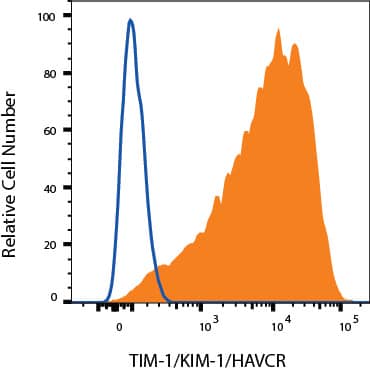Mouse TIM-1/KIM-1/HAVCR APC-conjugated Antibody
R&D Systems, part of Bio-Techne | Catalog # FAB1817A


Key Product Details
Validated by
Species Reactivity
Validated:
Cited:
Applications
Validated:
Cited:
Label
Antibody Source
Product Specifications
Immunogen
Tyr22-Thr212
Accession # NP_001160104
Specificity
Clonality
Host
Isotype
Scientific Data Images for Mouse TIM-1/KIM-1/HAVCR APC-conjugated Antibody
Detection of TIM‑1/KIM‑1/HAVCR in Mouse Splenocytes by Flow Cytometry.
Mouse splenocytes treated with 200 ng/mL LPS for 16 hours were stained with Rat Anti-Mouse B220/CD45R PE-conjugated Monoclonal Antibody (FAB1217P) and either (A) Rat Anti-Mouse TIM-1/KIM-1/HAVCR APC-conjugated Monoclonal Antibody (Catalog # FAB1817A) or (B) Rat IgG2BAllophycocyanin Isotype Control (IC013A). View our protocol for Staining Membrane-associated Proteins.Detection of TIM-1/KIM-1/HAVCR in HEK293 cells transfected with Mouse Tim-1 by Flow Cytometry
HEK293 cells transfected with Mouse Tim-1 were stained with Rat Anti-Mouse TIM-1/KIM-1/HAVCR APC-conjugated Monoclonal Antibody (Catalog # FAB1817A, filled histogram) or isotype control antibody (Catalog # IC013A, open histogram). View our protocol for Staining Membrane-associated Proteins.Applications for Mouse TIM-1/KIM-1/HAVCR APC-conjugated Antibody
Flow Cytometry
Sample: Mouse splenocytes treated with LPS; HEK293 cells transfected with Mouse Tim-1
Formulation, Preparation, and Storage
Purification
Formulation
Shipping
Stability & Storage
- 12 months from date of receipt, 2 to 8 °C as supplied.
Background: TIM-1/KIM-1/HAVCR
TIM-1 (T cell-Immunoglobulin-Mucin; also known as KIM-1 or HAVCR) is a 70-80 kDa, type I transmembrane glycoprotein member of the TIM family of immunoglobulin superfamily molecules (1-4). This gene family is involved in the regulation of Th1 and Th2-cell-mediated immunity. In mouse, there are eight known TIM genes (# 1-8) vs. only three genes in human (# 1, 3, and 4) (1, 2). Mouse TIM-1 and -2 are counterparts of human TIM-1 while mouse TIM-5 through 8 have no human counterparts (2). Mouse TIM-1 is synthesized as a 305 amino acid (aa) precursor that contains a 21 aa signal sequence, a 216 aa extracellular domain (ECD), a 21 aa transmembrane segment and a 47 aa cytoplasmic domain (5, 6). The ECD contains one V-type Ig-like domain and a mucin region characterized by multiple T-S-P motifs. The mucin region undergoes extensive O-linked glycosylation. The mouse TIM-1 gene is highly polymorphic and, based on rat, may undergo alternate splicing (4, 6). For instance, HBA mice show a 15 aa deletion in the mucin region that occurs in BALB/c mice (6). This difference is associated with a decreased susceptibility to asthma. Other polymorphisms are also documented (6). In human, TIM-1 is known to circulate as a soluble form. It undergoes constitutive cleavage by an undefined MMP, releasing a 75-85 kDa soluble molecule (5). The same thing might be expected in mouse. The ECD of mouse TIM-1 is 50%, 39% and 80% aa identical to human, canine and rat TIM-1 ECD, respectively. The only two reported ligands for TIM-1 are TIM-4 and the hepatitis A virus (8, 9). However, others are believed to exist, and based on the ligand for TIM-3, one possibility might be an S-type lectin (10). TIM-1 ligation induces T cell proliferation and promotes cytokine production (1, 10). In particular, it induces IL-4 production, and requires the cytoplasmic tyrosine phosphorylation motif (5).
References
- Meyers, J.H. et al. (2005) Trends Mol. Med. 11:1471.
- Kuchroo, V.K. et al. (2003) Nat. Rev. Immunol. 3:454.
- Mariat, C. et al. (2005) Phil. Trans. R. Soc. B 360:1681.
- Ichimura, T. et al. (1998) J. Biol. Chem. 273:4135.
- de Souza, A.J. et al. (2005) Proc. Natl. Acad. Sci. USA 102:17113.
- McIntire, J.J. et al. (2001) Nat. Immunol. 2:1109.
- Bailly, V. et al. (2002) J. Biol. Chem. 277:39739.
- Feigelstock, D. et al. (1998) J. Virol. 72:6621.
- Zhu, C. et al. (2005) Nat. Immunol. 6:1245.
- Meyers, J.H. et al. (2005) Nat. Immunol. 6:455.
Long Name
Alternate Names
Gene Symbol
UniProt
Additional TIM-1/KIM-1/HAVCR Products
Product Documents for Mouse TIM-1/KIM-1/HAVCR APC-conjugated Antibody
Product Specific Notices for Mouse TIM-1/KIM-1/HAVCR APC-conjugated Antibody
For research use only
